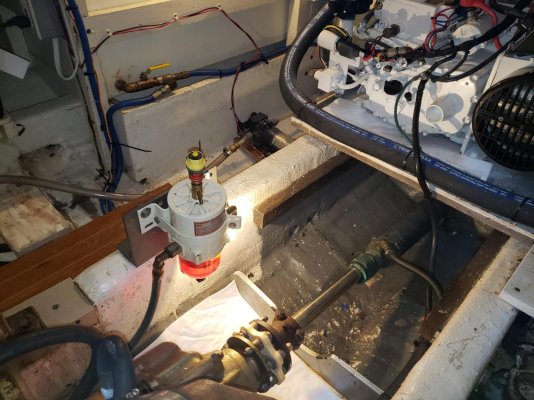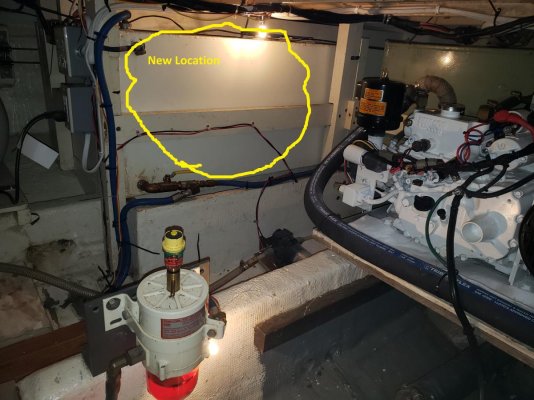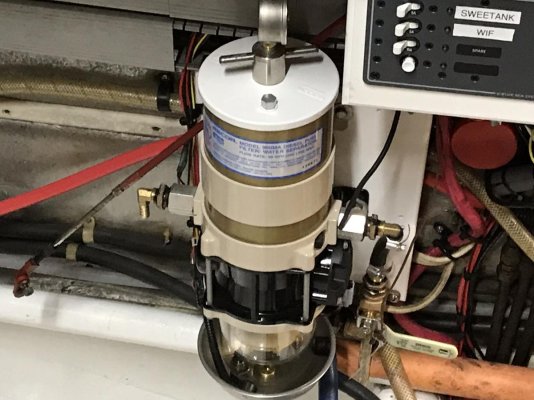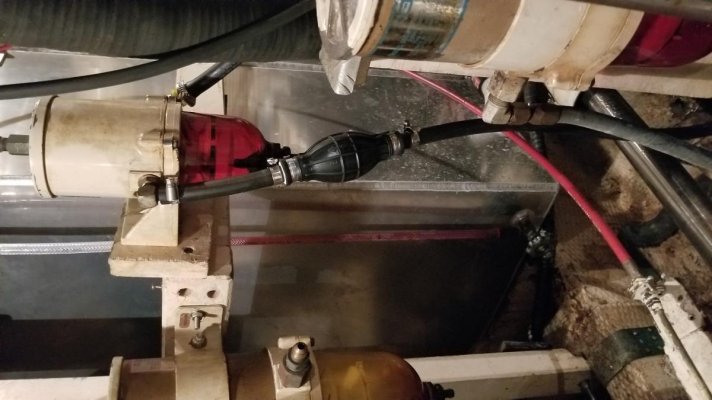SailorGoneBad
Veteran Member
The primary filter (Racor 500 with 30 micron element) is located as shown just aft of the engine on the starboard stringer. This is not a terrible location. It is below the tank so it gravity primes even when the tank is low on fuel. But it is kinda in the way when you need to go down there and I am always afraid I am going to break the vacuum gauge off with my knee.
I have this nice big blank space on the side of the starboard fuel tank that would make a wonderful home for a new two-stage primary filtration system.
Pros:
1) Makes access to the engine room easier.
2) Easier to drain and change the filter element.
Cons:
1) Need to add priming pump to fill the Racor 500FG unless tank is mostly full.
2) A little challenging to get a path to the on-engine fuel pump that only has one low spot between the filter and the pump. (I think I can do it). The current setup lets you break that path into two parts but since I would not have a filter there, I would need to go the entire distance in one shot.
My plan:
1) Add a self priming filter head in front of the Racor 500FG (such as a Racor 400 series with 30 micron filter or another vendor's filter head with a pump).
2) Change Racor 500FG to 10 microns.
3) Very carefully route fuel line so it only has one valley.
I have not experienced any real problem with the existing setup but as I get less nimble anything making access easier is a good thing. Adding an additional "mud" filter should give me more reserve filtering should I encounter a bad tank of fuel.
I would love have your thoughts. Especially any thoughts on fuel hose connections (i.e. A1-15 with barbs and double hose clamps or pre-made lines brass connections or throw caution to the wind and use push-loc connections on high quality non-coast guard approved hose.
Thanks,
David
I have this nice big blank space on the side of the starboard fuel tank that would make a wonderful home for a new two-stage primary filtration system.
Pros:
1) Makes access to the engine room easier.
2) Easier to drain and change the filter element.
Cons:
1) Need to add priming pump to fill the Racor 500FG unless tank is mostly full.
2) A little challenging to get a path to the on-engine fuel pump that only has one low spot between the filter and the pump. (I think I can do it). The current setup lets you break that path into two parts but since I would not have a filter there, I would need to go the entire distance in one shot.
My plan:
1) Add a self priming filter head in front of the Racor 500FG (such as a Racor 400 series with 30 micron filter or another vendor's filter head with a pump).
2) Change Racor 500FG to 10 microns.
3) Very carefully route fuel line so it only has one valley.
I have not experienced any real problem with the existing setup but as I get less nimble anything making access easier is a good thing. Adding an additional "mud" filter should give me more reserve filtering should I encounter a bad tank of fuel.
I would love have your thoughts. Especially any thoughts on fuel hose connections (i.e. A1-15 with barbs and double hose clamps or pre-made lines brass connections or throw caution to the wind and use push-loc connections on high quality non-coast guard approved hose.
Thanks,
David





